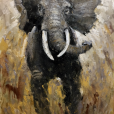From Then to Now
I WAS BORN at an early age on the Red River in Clay County, Texas. Our house was about 25 miles from Henrietta, which factored into my birth occurring at home. My parents (Claude and Mary) were of modest means, perhaps even prosperous in a hard-work, sweat-equity kind of way. My mom and dad were very industrious. In addition to farming and ranching, they also simultaneously owned and operated a country store (everything from groceries to shoes), a blacksmith shop, a cotton gin, and a cattle/grain hauling operation. As you might guess, they were busy people, night and day.
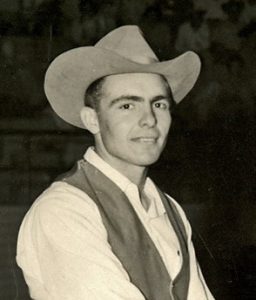
I have one sister, Mary Ruth, and had three brothers, Doodle, Jimmy, and Bob. Of the brothers, only Bob survives today. We were a pretty typical country family, except our parents were probably involved in more things than most people. In addition to work, they were into volunteer activities that helped our little country community and, later, Henrietta.
Jimmy died of brain cancer at age nine. My oldest brother, Doodle, now also deceased, was seven years older than me—too big a gap for him and me to have a very close relationship. I’m two years younger than our sister, who wanted as little as possible to do with rough and tumble boys like my younger brother and me, but she was stuck with us. She’s a real sweetheart—as good a person as I have known.
School was a mile walk from our house (uphill both ways, of course) in a two-room building, one teacher in each room, first grade through high school. Three years after I entered first grade, the school closed and we started riding a bus to school in Henrietta. The closing of the Stanfield community school was caused by the migration of rural people into towns for jobs at the end of World War II. So, from fourth grade through high school, we had a long commute each morning and evening on the school bus.
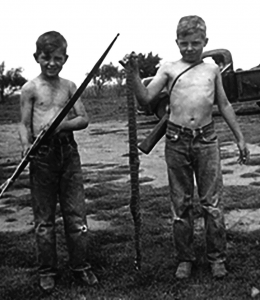 Bob and I roamed the pastures and river bottoms daily in search of adventure. Here we had just killed a rattlesnake with a bow and arrow.
Bob and I roamed the pastures and river bottoms daily in search of adventure. Here we had just killed a rattlesnake with a bow and arrow.
I lived with my widowed grandmother from about age two until I was nine years old. I moved in with her when my mother was expecting my younger brother and, for a long time, just didn’t move back. These were also the years the family was battling Jimmy’s cancer. My grandmother lived within walking distance of my family’s home.
My younger brother and I spent most of our non-school time seeking adventure. Our activities involved working, playing, hunting, fishing, or fighting. We disassociated after each daily fight (sometimes several daily), but soon reunited. We were about the same size but he was tougher. There was no one else available to play or work or hunt or fish or have a trapline or otherwise kick around with. So, it was each other or nothing. The process made us best friends, and we still are.
LIKE MOST COUNTRY kids, we grew up rather independently, with few rules. Mother was the enforcer of the few regulations that did exist. Her most emphatic rule was that fighting was not allowed inside the house because of the resulting damage (to the house, not Bob and me). Of course, our altercations sometimes started inside and we’d fight all the way out—a somewhat chaotic exit that frequently destroyed the screen door. The only physical discipline I ever received from my dad followed one of these screen door destructions. He rode up on horseback just as the flimsy door splintered. Being weary of those repairs, he jumped off his horse, grabbed me by one arm, pulled the latigo off his saddle, and gave me a good going over with it—his version of the modern-day
“time out,” I suppose. My brother, no dummy, escaped to the river while my punishment session was in progress.
Bob and I spent our summer’s mostly baling and haul- ing hay and working cattle. The cattle work was primar- ily doctoring calves for screwworms and pulling cows out of quicksand bogs in the Red River (getting a cow out of quicksand on a hot August afternoon without doing per- manent damage to the cow, your horse, or yourself would make you wish you were a town boy). Bob was a natural cowboy and loved every part of being on horseback. He could do it all well. I was neither as good at it nor as fond of it.
I have always been a reader. I developed the habit by reading a big book my grandmother owned, Treasury of the Familiar. It is a compilation of noted speeches, quotes, stories, poems, and inscriptions covering the full spectrum of human history and experience—including such variety as Socrates’s final words, Robert Service’s Cremation of Sam McGee, and Shakespeare’s Seven Ages of Man. It was my nighttime entertainment, and I spent untold hours reading that book during the years I lived with my grandmother and afterward. It had a significant impact on my life.
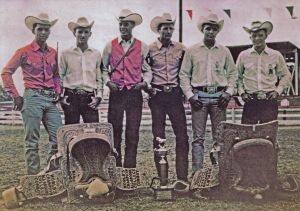 Southwest Region champion team at the National Finals Rodeo in Colorado. (left to right) Clyde Fort, Jerry Harlan, Jerry Carson, Ed Workman, me, Benton Wardlaw
Southwest Region champion team at the National Finals Rodeo in Colorado. (left to right) Clyde Fort, Jerry Harlan, Jerry Carson, Ed Workman, me, Benton Wardlaw
I also loved seeing the Saturday Evening Post magazine, usually with Norman Rockwell cover paintings, and always with some of the great story illustrations created by art- ists of that time. Those covers and illustrations kindled my early interest in sketching and drawing and looking at art. In more recent years, Lanita and I have assembled a mod- est collection of art from the artists whose work appeared in those popular magazines.
My degree in design from Texas Tech came about indirectly. I actually attended the university in Lubbock to be on the rodeo team. I was required to select an academic major. I chose Advertising Art & Design (the only art curriculum available) because, other than being a rodeo cowboy, art was as close to a “calling” as I possessed. At that time, the degree was in the School of Architecture, which was in the School of Engineering. Caveman days.
I STILL ENCOUNTER former rodeo cowboys who speak of having an art sketch I gave them on a rodeo trip years ago. Lubbock was a good base from which to rodeo, as I could compete in more than 100 rodeos a year while taking a full schedule of college classes. You could participate in a rodeo in most of Texas, New Mexico, Colorado, and Oklahoma, and, by driving all night, still attend morning classes. Of course, the night drives back to Lubbock were miserable. Fighting sleep while driving with a couple of horses in a trailer for most (or all) of the night was a con- test. But, by putting up with the wear and tear, you could compete in at least two or three rodeos a week in season, sometimes more.
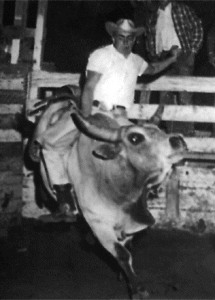 A good start on a bull at Pampa, Texas. Unfortunately, this ride did not end as well as it began.
A good start on a bull at Pampa, Texas. Unfortunately, this ride did not end as well as it began.
In competition, I rode bareback broncs and bulls, and was a steer wrestler. I was pretty lucky when it came to winning. Bull riding was the least fun, as the immense power of the bulls kept me sore and bruised. I thoroughly enjoyed both bareback bronc riding and steer wrestling, partially because, for me at least, those events allowed for greater technique and finesse. I looked forward to every one of the steer wrestling runs and bucking horse rides I ever had (okay—some more than others).
When learning about my bull riding, people often ask about injuries. Messing with bulls certainly taught me that skin grows back and bruises heal, but bull riding did not create serious injuries for me. My fractured skull, cracked ribs, broken tailbone, the pelvic rearrangement, and a messed up wrist all came from bucking horses.
LANITA AND I married in 1962—easily the great- est thing that ever happened to me. The exact moment I knew I should marry her is still as clear as if it happened yesterday. At the time, I actually had done little more than be around her a few times after meeting her through her brother, a rodeo clown and bullfighter. When the moment of marriage revelation came, I was eighteen years old and passing through Salt Lake City going to rodeos in Idaho. A couple of weeks later in Ontario, Oregon, a bull slammed me into the ground and stomped a dinner-plate sized hoof onto my back. As I waited by the chutes to get my eyes re-focused and my tongue back into my mouth, I concluded that instead of heading on to South Dakota as planned, I should find a way back to Texas and Lanita. That began a four-year, on-and-off process of me convincing her of the glory that our united future could bring. Part of the problem was her mom, who didn’t allow her to date cowboys. Anyway, Lanita was, is, and will always be the best part of my life.

I have been blessed with a wonderful family. Our children, Hank and Holly, both lead successful lives in the Metroplex. Holly’s husband is Stuart McKay, a smart guy and a great dad to our two absolutely, beyond-a-doubt, perfect granddaughters, Zoe and Lily.
My rodeo career was destined to end soon after marriage for several reasons—a promise to Lanita, disenchantment with the travel, and riding-hand wrist injuries that wouldn’t heal.
My last rodeo was in Douglas, Wyoming, a couple of years after we married. Following it, we sold our bulldogging horse (a good one) for enough money to purchase a Volkswagen automobile, a clothes washer and dryer, and a Clarence Kincaid watercolor. That bulldogging-horse- financed art purchase was our first, and it stimulated a life- long interest in collecting art for both of us.
Throughout all this, Lanita worked at First National Bank of Lubbock and kept our lives together. I was just a happy- go-lucky cowboy, but she could, would, and did tend to the things that needed to be tended to.
LANITA AND I have very similar tastes, including admiring the same kinds of art. For example, we once walked separately through a large antique store in France with hundreds of paintings on the walls. Later we reunited, each wanting to show the other a painting somewhere in the store. It was the same painting, and somewhat similar experiences have occurred several times.
 Following the conclusion of my rodeo career, we soon owned an ad agency that included a movie production division—an interesting experience.
Following the conclusion of my rodeo career, we soon owned an ad agency that included a movie production division—an interesting experience.
Working with the Tech rodeo while president of the Tech Rodeo Association, I had learned that I really enjoyed the promotion and marketing activities that were involved. So, after the Wyoming rodeo finale, I started sales work
with a Lubbock advertising agency and entered an entirely new world. After about a year in Lubbock, I was offered a job in Abilene, the home office of the ad agency. Shortly after moving to Abilene, I was assigned to work on a proj- ect at the World’s Fair in New York City.
I would fly to New York, stay a couple of weeks, come home for a few days, and then go back to New York. That was the schedule for a year. In some ways, the business travel was worse than going to 100 or more rodeos a year. But, working in New York’s advertising world in the “Mad Men” era of the 1960s offered some new educational opportunities for a guy fresh from riding bulls and wrestling steers. In addition to learning new stuff, I also had to unlearn some things.
During the New York experience, our son, Hank, was born. Two years later, about the same travel experience was repeated when we were pregnant with our daughter, Holly. I again worked in New York, this time on a project to launch a fourth national television network. Our new network was based on the idea of filming Hollywood entertainers in Las Vegas during the daytime and feeding the shows to TV stations in prime time. The network aired nationally for about three months, but, unfortunately, we could not sell enough long-term national advertising, and it went off the air. Ahead of our time, I guess. Anyway, that venture kept me in New York pretty much constantly for more than a year. And, I might add, it provided multiple new experiences for a 26-year-old country boy.
Back in Abilene, I was promoted to manager of the Abilene advertising agency, but I left after about three years to start my own company. About the time I turned 30, the owner of the original ad agency died unexpectedly. A partner and I borrowed money to purchase the company and merge it with mine.
FOR A WHILE, staying primarily in Abilene allowed me more time to paint at night and on weekends. I sold a series of watercolors to Austin’s largest art dealer at the time, the Country Store Gallery. They had high-end clientele, and collectors such as Lyndon Johnson and John Connally acquired my paintings.
 This is my studio in our office downtown. There I work under the watchful eye of a buffalo shot on the Charles Goodnight ranch in the Palo Duro Canyon in 1896 (while Goodnight lived there). Lanita really liked the painting on the easel when it was finished . . . so guess who has it now.
This is my studio in our office downtown. There I work under the watchful eye of a buffalo shot on the Charles Goodnight ranch in the Palo Duro Canyon in 1896 (while Goodnight lived there). Lanita really liked the painting on the easel when it was finished . . . so guess who has it now.
My first one-artist show was in Gallery III in Ruidoso, New Mexico. The show opened on Saturday afternoon and, for a time, looked like a disaster; no one came. But, when the horse races concluded for the day, a very nice crowd appeared to see the watercolors and charcoal draw- ings. All 32 pieces in the show were sold.
Abilene Savings and Loan presented my first Abilene show a few months after the Ruidoso success. It was a sellout, also. A series of shows and exhibitions followed in various places over the next several years. I was very lucky with the solo shows, as it was a long time before I had a show in which every painting did not sell. I do not want to sound too mercenary here, but sales can be a non-emo- tional barometer of the art-work’s appeal.
I worked with the Texas Art Gallery in Dallas during this time, which was pretty exciting. Western art became hot nationally, partially due to the efforts of the Texas Art Gallery. The Gallery sold paintings successfully all year, and it also conducted a fall show in the Adolphus Hotel’s giant ballroom. About twenty gallery artists (all with reputations far exceeding mine) participated with a half-dozen paintings each. At the appointed hour, the ballroom doors would open and the crowd waiting in the Adolphus lobby would rush in to see the paintings. The gallery owner’s goal was to announce, before 60 seconds had elapsed, that the show was “sold out!” Amazingly, he was able to make that announcement year after year.
Those shows exposed Lanita and me to an entirely new group of people and provided some entertaining experiences. Bunker Hunt, one of the billionaire members of the famous Hunt family, stood before one of my paintings (priced at about $1,000) and said, “You know, Zachry, I like that painting, but if I bought it, and it went up ten times in value, I still wouldn’t have anything!”
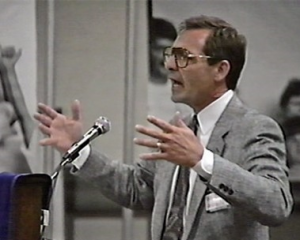 Dozens of volunteers conducted a major campaign to have Abilene designated an All-American City, a tough national competition. The final phase was a presentation to a jury in Phoenix, which I was privileged to make. We were an excited bunch when the jury announced that Abilene had won.
Dozens of volunteers conducted a major campaign to have Abilene designated an All-American City, a tough national competition. The final phase was a presentation to a jury in Phoenix, which I was privileged to make. We were an excited bunch when the jury announced that Abilene had won.
IN ADDITION TO Dallas, I also worked with galleries in Arizona and Palm Desert, California—and had some great, fun experiences. But, I eventually grew weary of long-distance business. Sales were good, but I was shipping paintings to people I never saw or knew. Lanita and I preferred the personal experience of dealing directly with customers, and so we gradually disengaged from the gallery circuit.
Today, there is a Zachry Gallery within Abilene Frame & Art in Abilene. With the great staff of the store, this exclusive display space works out really well for us. It provides an always-available place for people to see both original paintings and giclees (prints on canvas).
Dealing directly with clients was rewarding, though not every moment was perfect. Many years ago, a collector drove up from New Orleans to look at paintings. He purchased a large one and left, stopping in Dallas for the night. He phoned the next morning and said, “H. C., last night in the Anatole parking lot, someone knocked out my car win- dow, hit the trunk release button, and took everything.” I quickly asked, “You mean the thieves stole the painting?” “No,” he said, “but they unwrapped and looked at it!”
THE MORE I enjoyed the forgiving nature of oil painting (you can cover mistakes with paint!) the more I moved away from charcoals and watercolors, eventually leaving them completely. For the last 20 years or so, I have only worked in oil paints.
I continued to paint landscapes, but also began to add scenes from cities and foreign lands. Lanita and I have traveled quite a lot, through a combination of advertising activities, the art world, and our own personal interests. We were able to see some wonderful places, and I began to incorporate those subjects into my paintings.
People have always seemed to respond well to my paintings. I try to paint subjects and create scenes to which people emotionally respond. I want my paintings to stir a memory, to remind someone of a place or a person or an experience that is important to them.
A connection—an invisible line connecting my canvas and the viewer’s brain—is my goal.
Some artists are committed to painting their own view of the world, or exposing their innermost thoughts, or whatever. That is great—for them. But my objective is different. I am not trying to do something for me. Instead, I am trying to create something to which the viewer connects and responds. I want my painting to hold the viewer by the hand and lead them through a mental portal to a particular time or experience or place or feeling in their own life.
I HAVE TWO art studios—one at my downtown business office and one at home. I’ve never had the advantage— or disadvantage—of working in a solitary environment. Consequently, I do not paint in marathon stretches—it is 20 minutes here, two hours there. The process is a bit weird, but it works for me. For my entire career, I have had multiple initiatives going simultaneously, so it feels natural for the painting part of my life to work that way also.
Lanita and I have enjoyed interactions with three overlapping cultural audiences. First, we were involved in the rodeo world and its inhabitants. Then, the business community and the art environment both added their universes to our lives. The variety of people and circumstances we’ve encountered has greatly enriched us.

OKAY, A BIT about our part of the business world, since it has and does occupy a large segment of my life. I’m currently chairman of Zachry Associates Inc., an Abilene/Dallas advertising, research, and fund raising company, and Zachry Publications, LLP, a state-wide magazine and directory publishing and conference management company with offices in Abilene and Midland.
I started, with partners, Caswell, Zachry, Grizzard, LLC of Dallas, an endowment development company. Lanita and I own Zachry Studio/Gallery, Inc. I also founded Paper Tiger Printing and Mail Advertising Corporation of Abilene, but have since moved them on to other owners.
I’ve always tried to be involved in our city as a community advocate, including one or more terms as president, chairman, and/or trustee of: Abilene Chamber of Commerce, Southwest Golf Classic, Abilene Fine Arts Museum, Abilene Community Theater, Abilene Country Club, Abilene Philharmonic Association, Abilene Zoological Society, United Way of Abilene, West Texas Chamber of Commerce, ACU Advisory Board, Chisholm Trail Boy Scout Council, Better Business Bureau, Civic Center of Abilene, Abilene Cultural Affairs Council, Leadership Abilene, West Texas Rehabilitation Center, Sears Methodist Retirement Systems, Community Foundation of Abilene, Petroleum Club of Abilene, Abilene Improvement Corporation, Development Corporation of Abilene, Tax Increment Financing District, Texas Tech University Foundation, Fort Phantom Foundation, Sears Methodist Foundation, Taylor County Historical Foundation, Abilene Industrial Foundation, and A. V. Jones Foundation.
I HAD THE pleasure of helping to organize the Development Corporation of Abilene and served as its first president. With my assistance, Abilene became the first city in Texas to utilize sales tax collections for eco- nomic development. The origination of the Tax Increment
Financing District was another project in which I was deeply involved. I initiated and managed the conversion of the T&P railroad right-of-way into a six-mile greenspace through the center of town after chairing Abilene’s Centennial Celebration, and later coordinated the establishment of Frontier Texas!, a $12-million-dollar downtown historical entertainment and regional visitor center. Along with many other hard-working volunteers, I have had the good fortune to be involved in these and numerous other projects and initiatives on behalf of our city.
I’ve been fortunate to be honored as Abilene’s Outstanding Citizen, Outstanding Business Person, and Abilene’s Distinguished Citizen, and received the Hero of Tourism Award and Volunteer Service Award. The Texas Society of Architects cited me for contributions to Texas, and I’ve been inducted into the Texas Tech University Rodeo Hall of Fame.
If you are still reading at this point, let me say that I really appreciate you for looking through this online collection of my paintings. The images contain a lot of memories for me, and I hope they generate some for you as well.
—H. C. Zachry

